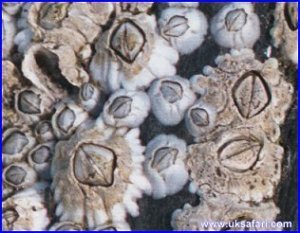Most likely, acorn barnacles.
Let me guess, they look like tiny volcanoes? And they hurt if you rub up against them?
That is the outer shell made of calcium. They put this protective layer up when they are not under water.
When it is hide tide the acorn barnacle opens up the volcanoes structure and extends tiny little legs (cirri) all about to gather food circulating in the ocean water.
If you have digested this correctly, you now know the acorn barnacle finds a suitable spot once it is “an adult” and stays there for THE REST OF THEIR LIFE. gulp.
Image (c) uksafari.com.
Do you have another great question? Check out www.beachchairscientist.com and enter your request!













What people are saying …